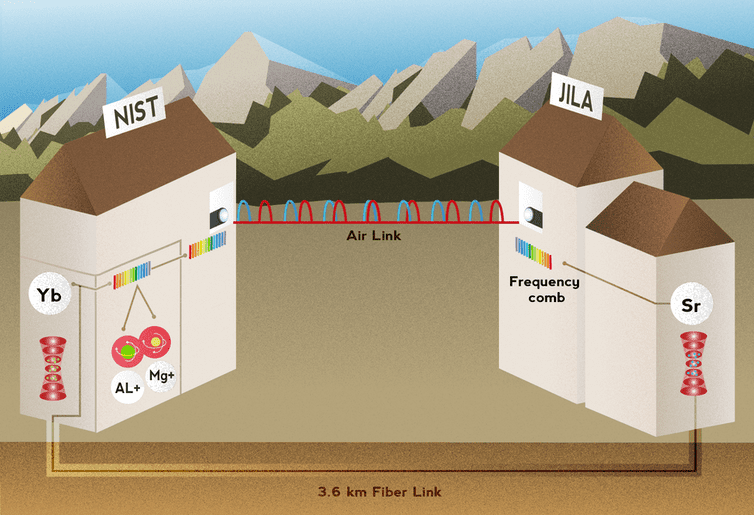
By employing a novel method that linked clocks with ultrafast lasers, physicists at the University of Colorado have demonstrated the most accurate optical atomic clock. These incredibly accurate clocks, which agree within 1 part in 10¹⁸ even though they’re kilometers apart, are even more accurate than conventional atomic clocks, the standard we currently use to define the second. Aside from setting a new standard for the second, optical atomic clocks may also be used in fundamental research, such as for detecting gravitational waves.
Since the ancient Egyptians and Babylonians, people have sought to measure the time of day as accurately as possible. At first, our time-keeping instruments were rudimentary, consisting of sundials and charts that track the movement of celestial bodies to identify changing seasons.
Huge leaps in measuring time were made in the 16th and 17th century by Galileo Galilei and Christiaan Huygen the use of a pendulum that ticked at a fixed frequency. This “oscillating” clock laid the foundation for basically all subsequent timing devices.
Although they operate according to the same principle — an oscillator with a resonance — the main difference between an old pendulum clock and a super modern atomic clock is the frequency of vibration. The smaller, higher frequency an oscillator is, the more stable and pure its resonances will be, thereby making these clocks more reliable.
An atomic clock measures time by counting the flipping frequency of the spin in the electrons of cesium atoms. The atomic resonance is so sharp that it can tell if a quartz crystal clock (i.e. typical clock found in everyday devices) wanders off from the right time by less than one part in 10¹⁵, or a millionth of a billionth.
This explains why the second is officially defined as 9,192,631,770 caesium electron spin flips.
Why on Earth would we want to keep time this precisely? As a matter of fact, the importance of highly precise time-keeping cannot be underestimated. Global Positioning System (GPS) satellite navigation systems rely on time-stamped signals to provide us with a precise location of a GPS receiver. If there were no atomic clocks, there would be no effective GPS. Highly precise timekeeping is also paramount in the financial industry, among other things, for time-stamping transactions in the banking sector or the stock market.
Every decade, the accuracy of atomic clocks has improved by an order of magnitude since their invention. Now, the next leap forward may come from optical clocks.

Theoretically, an optical clock can offer extremely high-frequency precision and stability, far exceeding the performance of the best cesium atomic clocks currently in use. The problem is that optical clocks haven’t been synced over large distances. If these clocks are ever to be useful and trusted, they need to read at the same time even when they’re thousands of kilometers apart.
A breakthrough was reported at the University of Colorado, where physicists employed a new way of linking clocks with ultra-fast lasters. They used multiple clocks based on different types of atoms — ytterbium, aluminum, and strontium. The strontium clock was placed in the University of Colorado, while the other two were housed at the US National Institute of Standards and Technology.
The clocks were connected directly through the air by a laser beam that traveled over 1.5 kilometers between the two buildings. This link was just as reliable as that provided by 3.6-kilometer optical fiber under the road. The clocks agreed with each other within 1 part in 10¹⁸ — that’s precise enough to measure distortions in space-time, which would make them ideal for detecting gravitational waves. They could also be sensitive enough to detect very subtle vibrations in the Earth’s crust, which could be used to predict volcanic eruptions with more time in advance than we can today.






